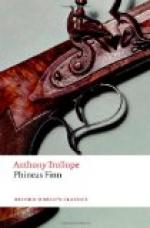Up to that moment he had never heard of Madame Max Goesler. Lady Glencora, in introducing them, had pronounced the lady’s name so clearly that he had caught it with accuracy, but he could not surmise whence she had come, or why she was there. She was a woman probably something over thirty years of age. She had thick black hair, which she wore in curls,—unlike anybody else in the world,—in curls which hung down low beneath her face, covering, and perhaps intended to cover, a certain thinness in her cheeks which would otherwise have taken something from the charm of her countenance. Her eyes were large, of a dark blue colour, and very bright,—and she used them in a manner which is as yet hardly common with Englishwomen. She seemed to intend that you should know that she employed them to conquer you, looking as a knight may have looked in olden days who entered a chamber with his sword drawn from the scabbard and in his hand. Her forehead was broad and somewhat low. Her nose was not classically beautiful, being broader at the nostrils than beauty required, and, moreover, not perfectly straight in its line. Her lips were thin. Her teeth, which she endeavoured to show as little as possible, were perfect in form and colour. They who criticised her severely said, however, that they were too large. Her chin was well formed, and divided by a dimple which gave to her face a softness of grace which would otherwise have been much missed. But perhaps her great beauty was in the brilliant clearness of her dark complexion. You might almost fancy that you could see into it so as to read the different lines beneath the skin. She was somewhat tall, though by no means tall to a fault, and was so thin as to be almost meagre in her proportions. She always wore her dress close up to her neck, and never showed the bareness of her arms. Though she was the only woman so clad now present in the room, this singularity did not specially strike one, because in other respects her apparel was so rich and quaint as to make inattention to it impossible. The observer who did not observe very closely would perceive that Madame Max Goesler’s dress was unlike the dress of other women, but seeing that it was unlike in make, unlike in colour, and unlike in material, the ordinary observer would not see also that it was unlike in form for any other purpose than that of maintaining its general peculiarity of character. In colour she was abundant, and yet the fabric of her garment was always black. My pen may not dare to describe the traceries of yellow and ruby silk which went in and out through the black lace, across her bosom, and round her neck, and over her shoulders, and along her arms, and down to the very ground at her feet, robbing the black stuff of all its sombre solemnity, and producing a brightness in which there was nothing gaudy. She wore no vestige of crinoline, and hardly anything that could be called a train. And the lace sleeves of her dress, with their bright




